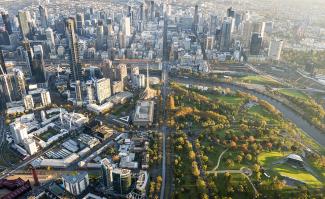John Wilson says there's a real paradox when it comes to funding infrastructure projects.
"We say we don't want to borrow. We don't want to raise taxes. We don't like user pays. We don't like selling assets – but we want better infrastructure!
"Something's got to give in that space."
Professor Wilson is the Chair of Engineers Australia's Victorian Infrastructure Report Card which assesses the State's infrastructure assets, mainly focusing on transport, energy, water and telecommunications.
He's also Executive Dean of the Faculty of Science, Engineering and Technology at Swinburne University of Technology.
His presentation Fixing Victoria's Infrastructure was part of the Transport and Infrastructure and Forum held at Engineers Australia Convention 2014.
Professor Wilson said that in the 2010 Victorian Infrastructure Report Card, most of the infrastructure assessed scored a ‘C’ (needing major changes).
In his talk, he raised some thought-provoking ideas on how to address Victoria's concerns, and the possibility of solutions that would benefit all States.
He said in Victoria the population's growing, the infrastructure is ageing, and funding projects can be a political hot potato.
Melbourne's population of 3.9 million people is due to swell to five million by 2025, and a 'disturbing' 60 per cent of new residents are more than 20 kilometres from the CBD.
"That brings all sorts of access issues into the debate," he said.
"Much of the infrastructure we depend on is 100-plus years old.”
Plus, there are some 20,000 kilometres of roads, 190 or so rail crossings, and ageing bridges.
He said more arterial road links were needed, and although Metro had done a great job, the rail system was fragile and tired.
On top of that: “We seem to have a transport plan every two years," he said.
“Things need to change.
"In Victoria, we're recommending we have some sort of advisory body like Infrastructure Australia to be able to coordinate and plan infrastructure.
"We believe this to be a very important part for any State Government to have a body which is well-represented by industry, the government and community to be able to prioritise these projects in a coherent way to end up with a pipeline of projects and with recommendations for a funding mix.
"We need to get this balance right."
He said Victoria had a backlog of $100 billion of infrastructure projects and criticised governments’ obsession about their Triple A credit rating, which led to ‘off the books’ funding arrangements such as public-private partnerships (PPPs).
“Somehow we've got to, I believe, change that mindset around the country, that actually long-term investment is really beneficial for all of us and it's going to bring great long-term investment returns to all of us,” he said.
He also called for greater vision, saying that a project such as the Sydney Harbour Bridge – with two rail lines and eight lanes of traffic – had been a bold idea that had changed Sydney forever.
"If you tried to put up that sort of project now, down the PPP path, you'd probably end up with two lanes in each direction. There's a lack of a vision,” he said.
"If you've got a vision, use infrastructure bonds to change things, you've got a chance, but you've got to have that vision to then bring the people along with you to get rid of this business that a Triple A rating being absolutely sacrosanct.
"We’re suggesting all States need some sort of local infrastructure planning body made up of business, government and the community for long-term planning, a pipeline of projects, recommend funding case by case, and look for the best value solution.”
